Red Korean ginseng - Roots
Processing
After the harvest, the fresh ginseng roots are washed carefully, sorted and heated or steamed at a high temperature. This causes a change in the internal proportion of the active ingredients in the root (ginsenosides), but they remain at a high level. This treatment causes the tissue of the root to change color from the original beige to a brown-red. After this the roots are dried at a low temperature.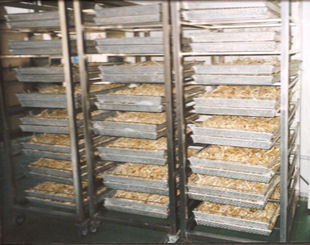 |
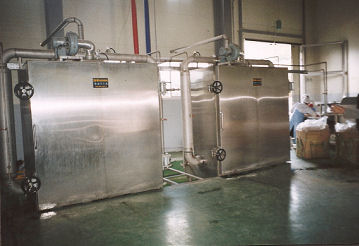 |
In roll cages the fresh Ginseng roots are driven in the steam rooms to create red Korean ginseng. | |
The steaming process mainly has an effect on the sugars in the Ginseng roots: the high temperature makes sure they are caramelized and this causes the red color of the roots. In the early days this used to be done to extend the shelve life of the Ginseng roots.
Roots are sorted according to standardized criteria, but can also be sorted to any specification that is desired.
Composition of the roots
Despite common belief, it is not always the case that roots with a longer growth period are better than younger roots. The level of active ginseng ingredients does increase gradually as the root ages, but it is the circumstances under which the plant develops that determine its ginsenosides levels.Different roots from one and the same piece of land with the same number of growth years and the same level of ginsenosides can have very different shapes and sizes. Therefore the larger roots don't necessarily have better qualities than the small ones.
The distinction between first and second grade is mostly based on visual aspects. Ginseng roots with (spots of a) divergent color, some damage or unattractive growth patterns are usually marked 'second choice'. The level of ginsenosides in first and second grade roots is equal and so is their strength.
Packaging
Normally any bulk quantities are packed in plastic bags in cardboard boxes or barrels.If desired smaller quantities can be packed in transparent plastic boxes.
| 220 gram | 600 gram | ||
|---|---|---|---|
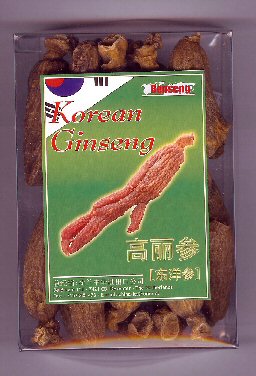 |
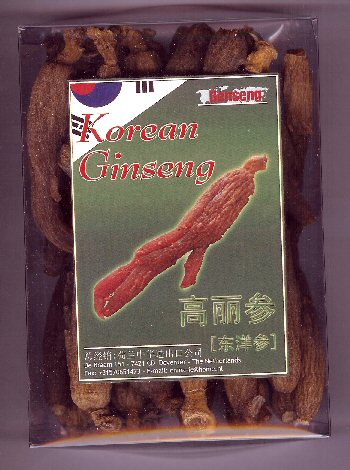 |
In smaller quantities Red Korean Ginseng roots can be packed in transparent plastic boxes. | |
Properties
Dry White and dry Red Korean ginseng roots are made from the same fresh Korean ginseng root. Therefore both roots have similar basic medicinal actions. The differences between red and white ginseng is preliminary found in taste and force. The heating process of Red Korean ginseng is causing a somewhat milder taste and milder, but at the end more powerful effects on the body then White Korean Ginseng.Different parts of the Red Korean Ginseng roots contain different levels of ginsenosides. The tiny hair-roots or fibers contain 2 to 3 times more ginsenosides than the main roots.
Know that the mutual levels of the individual ginsenosides in the fibers slightly differ from those in the main roots. Due to this, theoretically the fibers could have a slightly different effect on the body.
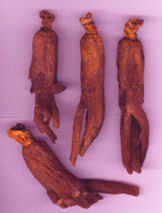 |
The Red Korean ginseng roots labeled "mixed size" (product code: RKWROO) still have side roots, but the tiny hair roots have been removed. |
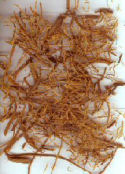 |
Red Korean Ginseng slender tails + fibers (product code: RKWRFO) contain the highest level of ginsenosides. |
The taste of the Red Korean Ginseng root can be qualified as bitter-sweet. As the level of ginsenosides rises, the root's bitter taste intensifies and the sweet taste declines.
Dried Red Korean Ginseng Roots are quite hard, thought a little bendy. Carefully heating them in an oven or microwave softens them, allowing them to be cut with a knife.
The active ingredients in Ginseng Roots (ginsenosides) are heat-resistant, and are not damaged or lost in the heating process.
Dosage
For optimal therapeutic results it is advised to take 30-60 mg of pure ginsenosides daily.The Red Korean ginseng roots "mixed size" still containing the slender tails or prongs but without the smallest root fibers (product code: RKWROO) contain an average level of about 1.5-2.5% ginsenosides. This would mean that a daily intake of about 2 to 4 grams of these roots would be sufficient.
Practical experiences have demonstrated that activity and effects of Ginseng do not decline proportionally as a daily dose is lowered.
There is no dangerous (damaging) maximum daily dose, but 7 mg ginsenosides is considered as a minimal dose. If you take less than 7 mg a day it will most likely not contribute anything.
When mixed with other herbs with active constituents a lower dose of Red Korean ginseng might be sufficient.
 |
 |
| previous | next |
